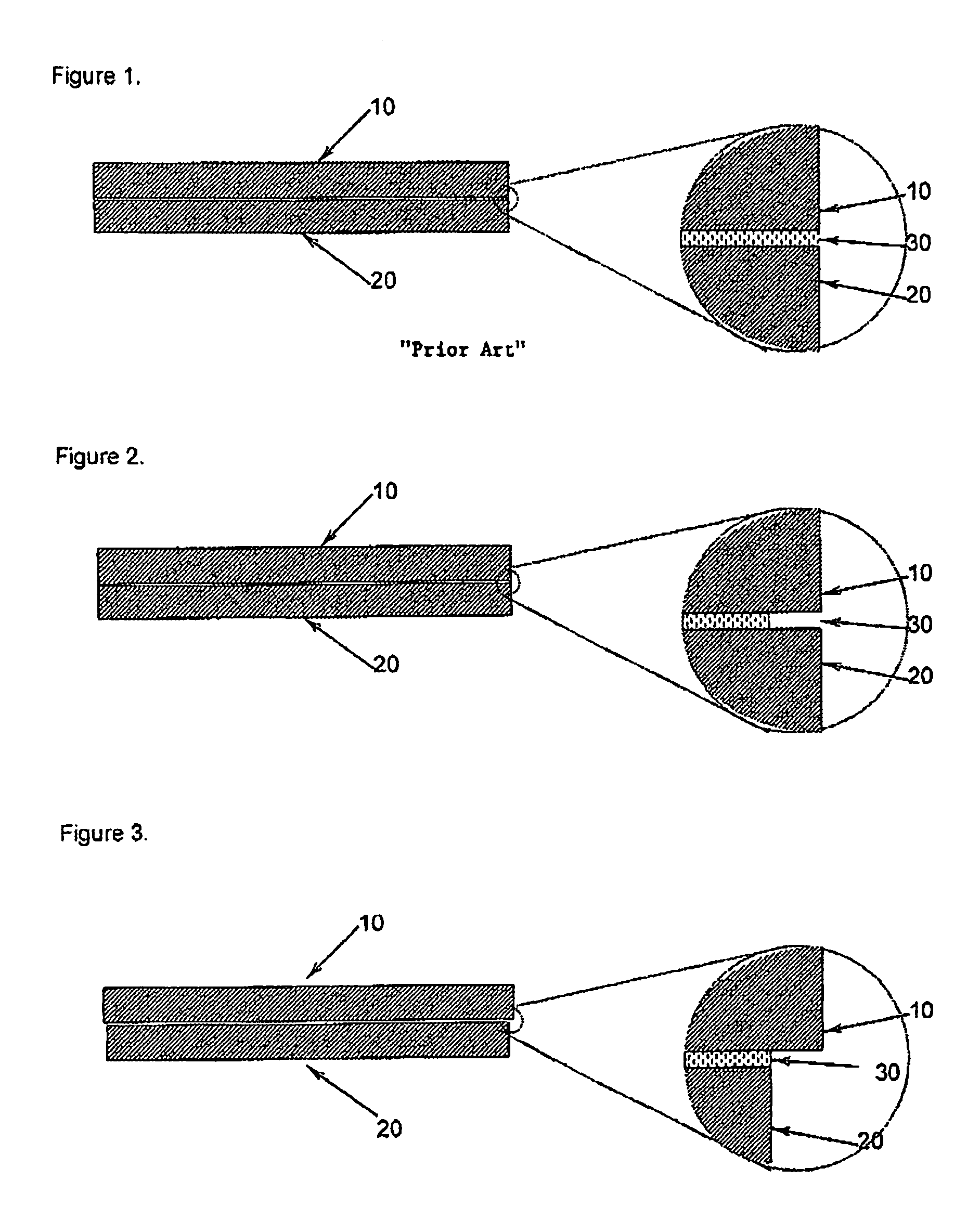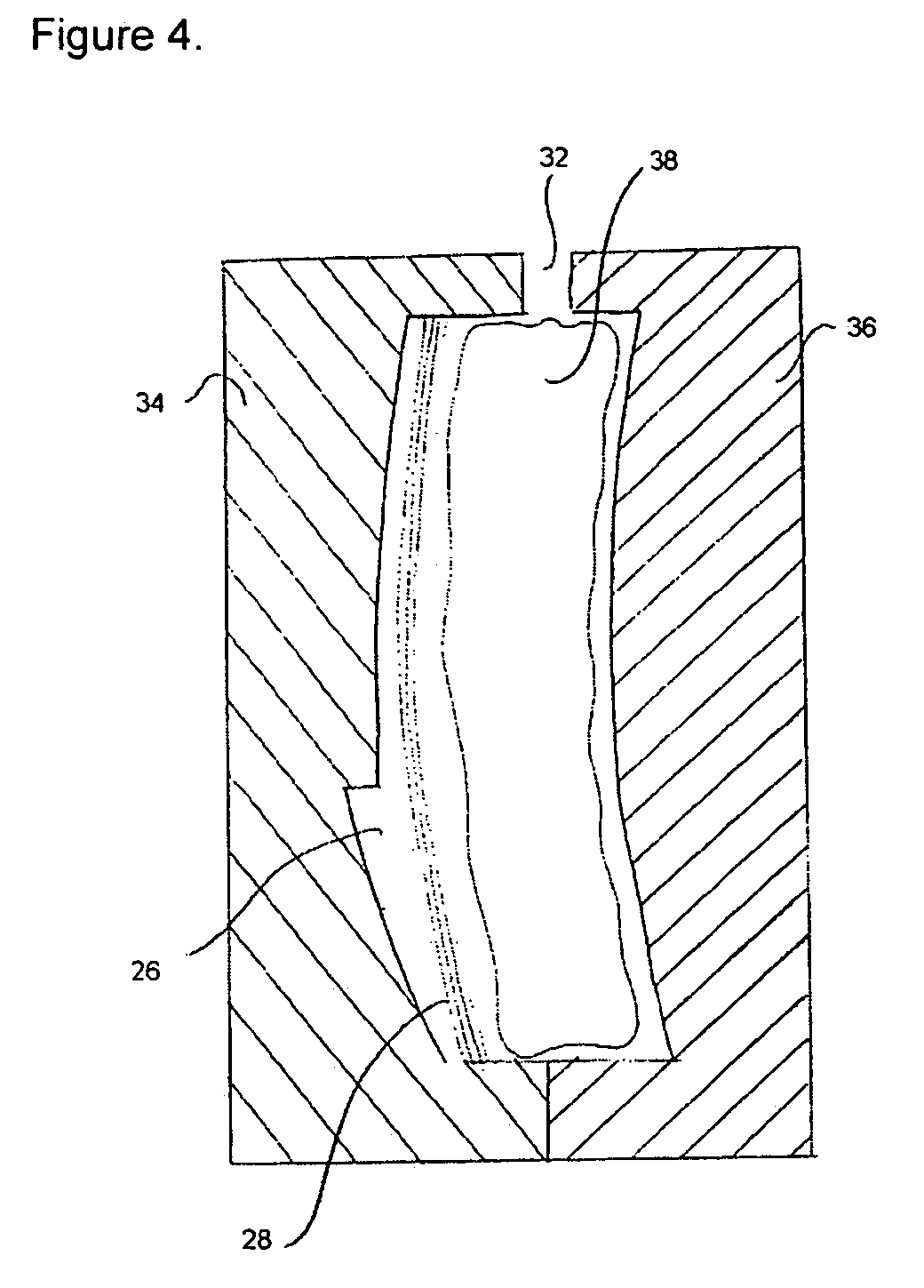Laminated functional wafer for plastic optical elements
a functional wafer and plastic optical element technology, applied in the field of laminated functional wafers, can solve the problems of bleed of the adhesive material and/or the functional layer material, the relative thickness of the coating is not suited for the surface application of a segmented, multi-focal lens, and the inability to meet the requirements of segmented, optical lens segments, etc., to achieve the effect of effectively and efficiently manufacturing plastic lenses and adding functional properties
- Summary
- Abstract
- Description
- Claims
- Application Information
AI Technical Summary
Benefits of technology
Problems solved by technology
Method used
Image
Examples
example 1
[0089]A photochromic polyurethane laminate having two 0.3 mm thick polycarbonate sheets bonded to a 102 μm cross-linked polyurethane layer, which contains about 1.2% of a gray photochromic compound, was made by Mitsubishi Gas Chemicals (Tokyo, Japan). The laminate was cut into 76 mm diameter wafers, which in turn were spherically formed into 5.7 diopter wafers. The back (concave side) polycarbonate sheet and the photochromic layer were trimmed off from the edge by 2 mm with a Horizon II bevel edger (National Optronics, Charlottesville, Va.) equipped with a rotary carbide steel blade. The resulted wafers were used to make a semi-finished 6-base flat top bi-focal lenses. The front (convex side) polycarbonate sheet faces the concave mold cavity. After the insert injection molding process with common molding parameters, the finished lens has an acceptable segment line. No polyurethane bleeding from the wafer is observed. The mold cavity and surrounding are free of material leftover, and...
example 2
[0090]A 20% polyurethane solution in tetrahydrofuran was obtained from a thermoplastic polyurethane CLC-93A (Thermedics Polymers, Boston, Mass.). To the solution were also dissolved 3.0% of a gray photochromic dye, 2.0% of Tinuvin® 144, and 2.0% of Tinuvine® 765. The solution was cast with a doctor blade on a silicone coated polyester release liner. The cast film was dried at 60° C. for 10 minutes on a hot plate and then 100° C. for another 30 minutes in a hot air dryer.
[0091]A 380 μm thick sheet of polycarbonate from GE (New York, N.Y.) was laminated to the dried film on the liner at ambient temperature. The obtained laminate has a liner on the top, a polyurethane photochromic layer in the middle, and a polycarbonate sheet with masking on the bottom. Next, a 74 mm diameter cutting die was used to kiss-cut the laminate from the liner side on to the polycarbonate sheet to define the size of the photochromic layer. After the liner and un-needed polyurethane film were removed, another ...
example 3
[0093]The procedure of Example 2 was followed, except the kiss-cut went through the first polycarbonate sheet and stopped at its masking film. The wafer so obtained had a polyurethane layer of 50 μm thick, and its back polycarbonate sheet and the photochromic layer were 1 mm smaller than the front polycarbonate sheet from the edge. It was used to make a 6-base semi finished flattop bi-focal lens without forming into a spherical shape. After the insert injection molding process with common molding parameters, the finished lens had an acceptable thin, sharp, crisp segment line. No polyurethane bleeding from the laminate was observed.
PUM
| Property | Measurement | Unit |
|---|---|---|
| Length | aaaaa | aaaaa |
| Length | aaaaa | aaaaa |
| Diameter | aaaaa | aaaaa |
Abstract
Description
Claims
Application Information
 Login to View More
Login to View More - R&D
- Intellectual Property
- Life Sciences
- Materials
- Tech Scout
- Unparalleled Data Quality
- Higher Quality Content
- 60% Fewer Hallucinations
Browse by: Latest US Patents, China's latest patents, Technical Efficacy Thesaurus, Application Domain, Technology Topic, Popular Technical Reports.
© 2025 PatSnap. All rights reserved.Legal|Privacy policy|Modern Slavery Act Transparency Statement|Sitemap|About US| Contact US: help@patsnap.com



